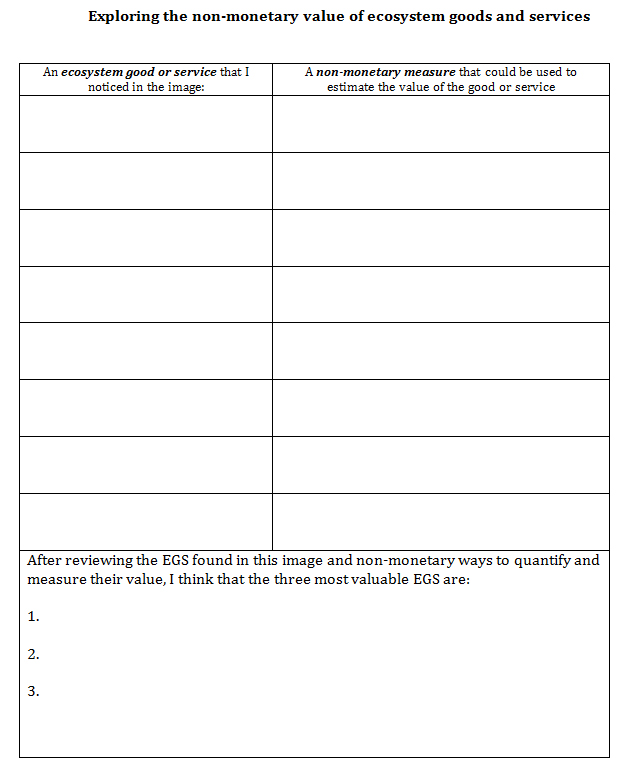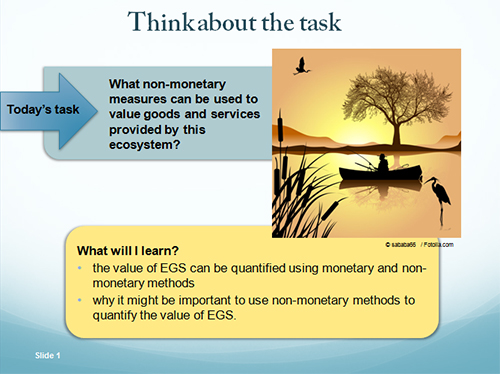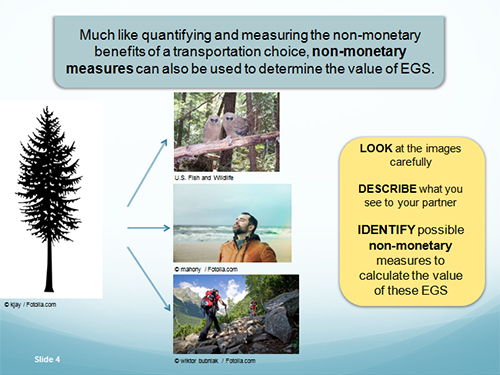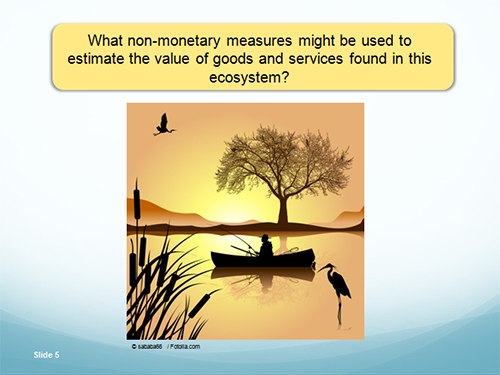Publications
Human Activity and the Environment – Teacher’s Kit
- 16-507-X
- Main Page
-
Lesson #1:
What is an ecosystem? -
Lesson #2:
What are ecosystem goods and services? -
Lesson #3:
How can the value of ecosystem goods and services be measured? -
Detailed lesson plan #1:
Can the value of ecosystems and ecosystem goods and services be measured? -
Detailed lesson plan #2:
The value of ecosystem goods and services in changing ecosystems -
Case study #1:
Thousand Islands National Park case study -
Case study #2:
Exploring methodologies for measuring ecosystem goods and services - Image collection
- More information
- PDF version
Lesson #3 How can the value of ecosystem goods and services be measured?
Overview
This PowerPoint lesson describes use of the seven slides in Set #3 and related learning activities to explore how the value of ecosystem goods and services (EGS) might be measured. Using the example of two transportation options, learners explore non-monetary methods to quantify and measure benefits. They compare monetary and non-monetary valuations for sample goods and services. Finally, they suggest possible non-monetary measures for determining the value of EGS portrayed in an image of an ecosystem.
Audience
- junior high school
- senior high school
- introductory post-secondary
Learning outcomes
- understand monetary and non-monetary valuation methods
- understand the importance of both valuation methods
Curriculum links
- grades 7 to 12 geography (ecosystems, geographic change), social studies (economics), biology (ecosystems and change), science, economics (accounting, valuation methods)
- post-secondary geography (ecosystems), environmental science (ecosystem accounting, ecosystem change)
Learning materials
- PowerPoint slide set #3: How can the value of ecosystem goods and services be measured? (PPT) (PDF) (HTML)
- Statistics Canada publication, Human Activity and the Environment 2013: Measuring ecosystem goods and services in Canada
- Image collection: Image # 8 (PDF) (HTML)
- Activity sheet #6: Exploring non-monetary benefits (DOC) (HTML)
- Activity sheet #7: Exploring the non-monetary value of ecosystem goods and services (DOC) (HTML)
- Activity sheet #8: Exploring strengths and weaknesses (DOC) (HTML)
Instructions
Think about the task
Display or project Slide 1 or provide a provocative image to prompt learner reflection on the question “What non-monetary measures can be used to value goods and services provided by this ecosystem?”
Guide learners in a discussion of how the non-monetary value of EGS might be quantified and measured. Encourage learners to consider why it might be important to find alternatives to monetary measures of valuation when determining the value of EGS.
Explore the ideas
Organize learners into small groups and provide groups with a copy of Activity sheet #6: Exploring non-monetary benefits.
Display or project Slide 2 and inform learners that they must decide which transportation option provides the greatest benefits.
Explain that while they could use monetary measures to guide their decision (for example, comparing the cost of the bicycle with the cost of the transit pass), their challenge is to think of non-monetary ways to quantify and measure the benefits of each transportation option. For example, they could compare the fitness benefits of each option by measuring the number of calories expended.
Guide learners in identifying other non-monetary ways of quantifying and measuring benefits. Instruct learners to record their ideas on Activity sheet #6 and then share with the class.
Learn about monetary valuation of ecosystem goods and services
Guide learners in reflecting on the images from Slide 3 and to think of what monetary measures might used to determine the value of trees. Three examples of EGS associated with trees are pictured (from top to bottom):
- timber and wood products
- clean air or air purification
- erosion control.
Consider prompting learners with a question such as: “What monetary measures could be used to determine the value of the goods and services provided by trees?” Remind learners that they are to think of how monetary value might be measured, and not calculate dollar amounts or actual values.
Possible examples include the market prices of timber and wood products, how much someone would be willing to pay to keep a tree, the value of lower health care costs associated with cleaner air, or money not spent on flood mitigation.
For more information on monetary valuation techniques refer to the Statistics Canada publication, Human Activity and the Environment 2013: Measuring ecosystem goods and services in Canada, page 21 and page 86 (Appendix B).
Learn about non-monetary valuation of ecosystem goods and services
Inform learners that similar to quantifying and measuring the benefits of a transportation choice, non-monetary measures can also be used to determine the value of EGS.
Display or project Slide 4 and ask learners to think of what non-monetary measures might be used to quantify and measure the value of the EGS provided by trees. Three examples of EGS associated with trees are pictured (from top to bottom):
- habitat for endangered species (e.g., spotted owls)
- clean air or air purification
- recreation.
Consider prompting learners with a question such as “What non-monetary measures could be used to determine the value of the goods and services provided by trees?” Possible examples include the number of endangered species that inhabit the trees, a decrease in air pollution or the number of hikers that visit the ecosystem.
Encourage learners to share and record additional suggestions of non-monetary measures. Review these responses and guide learners in grouping the suggestions into categories. Possible suggestions include categories of social, cultural and physical measures. Record and display these grouping suggestions.
For more information on non-monetary valuation techniques refer to the Statistics Canada publication, Human Activity and the Environment 2013: Measuring ecosystem goods and services in Canada, page 9.
Apply non-monetary measures
Display or project Slide 5 and inform learners that their next task is to determine what non-monetary measures might be used to determine the value of EGS found in the pictured ecosystem.
Provide each learner with a copy of Activity sheet #7: Exploring the non-monetary value of ecosystem goods and services and a copy of Image 8. Guide learners in identifying goods and services that might be found in this ecosystem. Remind learners that some EGS may be less obvious but are still valuable. For example, clean air might be a good provided by an ecosystem, and cattails might provide a service by cleaning air and water. Prompt learners to record their observations about EGS on Activity sheet #7.
Next, guide learners in identifying non-monetary measures that could be used to estimate the value of each identified good and service. Remind learners that they are to think of the measures, and not calculate actual values. Prompt learners to reflect on the categories of non-monetary measures.
After learners have identified a number of non-monetary measures, inform them that their challenge is to determine the three most valuable EGS from the pictured ecosystem. Instruct learners to consider the measures carefully and to record their reasons. Invite learners to share their decisions with the class, guiding the discussion to explore the similarities and differences.
Explore strengths and weaknesses
Display or project Slide 6 and distribute Activity sheet #8: Exploring strengths and weaknesses. Organize learners into small groups to consider the strengths and weaknesses of both methods of determining the value of EGS.
Prompt learners with questions such as:
- Which measures are easier to develop and use?
- Are there particular groups or perspectives that might favour one form of measures over the other?
- Are there situations where monetary measures might be more effective or appropriate than non-monetary measures?
- Are there situations where non-monetary measures might be more effective or appropriate than monetary measures?
- Are there situations where using both types of measures might be effective and important?
Conclude by posing the question: “Why might it be important to use non-monetary methods to quantify the value of ecosystem goods and services?”
Activity sheet #6

Description for activity sheet #6 (DOC)
Activity sheet #7

Description for activity sheet #7 (DOC)
Activity sheet #8

- Date modified:





